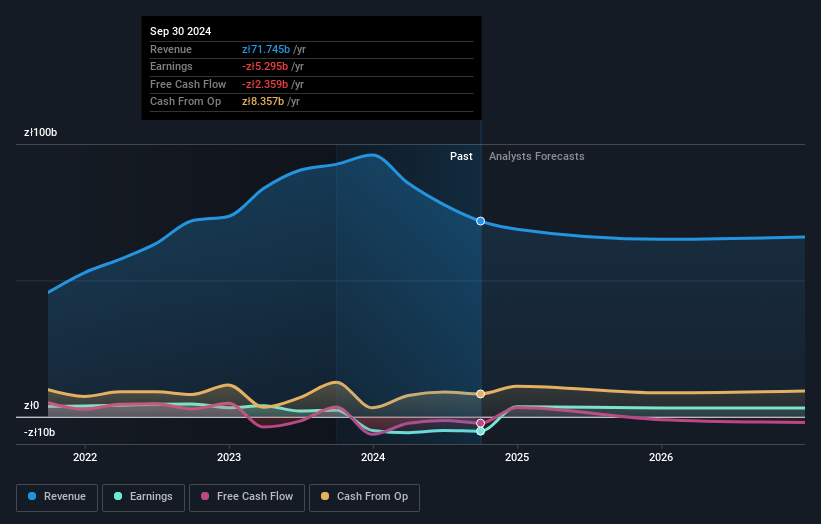- Poland
- /
- Electric Utilities
- /
- WSE:PGE
Painful week for state or government invested in PGE Polska Grupa Energetyczna S.A. (WSE:PGE) after 4.2% drop, institutions also suffered losses

Key Insights
- The considerable ownership by state or government in PGE Polska Grupa Energetyczna indicates that they collectively have a greater say in management and business strategy
- The State Treasury of the Republic of Poland owns 61% of the company
- Institutional ownership in PGE Polska Grupa Energetyczna is 28%
Every investor in PGE Polska Grupa Energetyczna S.A. (WSE:PGE) should be aware of the most powerful shareholder groups. With 61% stake, state or government possess the maximum shares in the company. In other words, the group stands to gain the most (or lose the most) from their investment into the company.
While institutions who own 28% came under pressure after market cap dropped to zł13b last week,state or government took the most losses.
In the chart below, we zoom in on the different ownership groups of PGE Polska Grupa Energetyczna.
Check out our latest analysis for PGE Polska Grupa Energetyczna

What Does The Institutional Ownership Tell Us About PGE Polska Grupa Energetyczna?
Institutional investors commonly compare their own returns to the returns of a commonly followed index. So they generally do consider buying larger companies that are included in the relevant benchmark index.
As you can see, institutional investors have a fair amount of stake in PGE Polska Grupa Energetyczna. This can indicate that the company has a certain degree of credibility in the investment community. However, it is best to be wary of relying on the supposed validation that comes with institutional investors. They too, get it wrong sometimes. If multiple institutions change their view on a stock at the same time, you could see the share price drop fast. It's therefore worth looking at PGE Polska Grupa Energetyczna's earnings history below. Of course, the future is what really matters.

Hedge funds don't have many shares in PGE Polska Grupa Energetyczna. The State Treasury of the Republic of Poland is currently the largest shareholder, with 61% of shares outstanding. With such a huge stake in the ownership, we infer that they have significant control of the future of the company. Nationale-Nederlanden Powszechne Towarzystwo Emerytalne S.A. is the second largest shareholder owning 5.0% of common stock, and Allianz Asset Management GmbH holds about 4.3% of the company stock.
While it makes sense to study institutional ownership data for a company, it also makes sense to study analyst sentiments to know which way the wind is blowing. Quite a few analysts cover the stock, so you could look into forecast growth quite easily.
Insider Ownership Of PGE Polska Grupa Energetyczna
The definition of an insider can differ slightly between different countries, but members of the board of directors always count. Company management run the business, but the CEO will answer to the board, even if he or she is a member of it.
I generally consider insider ownership to be a good thing. However, on some occasions it makes it more difficult for other shareholders to hold the board accountable for decisions.
We note our data does not show any board members holding shares, personally. Not all jurisdictions have the same rules around disclosing insider ownership, and it is possible we have missed something, here. So you can click here learn more about the CEO.
General Public Ownership
The general public-- including retail investors -- own 12% stake in the company, and hence can't easily be ignored. While this size of ownership may not be enough to sway a policy decision in their favour, they can still make a collective impact on company policies.
Next Steps:
It's always worth thinking about the different groups who own shares in a company. But to understand PGE Polska Grupa Energetyczna better, we need to consider many other factors.
Many find it useful to take an in depth look at how a company has performed in the past. You can access this detailed graph of past earnings, revenue and cash flow.
Ultimately the future is most important. You can access this free report on analyst forecasts for the company.
NB: Figures in this article are calculated using data from the last twelve months, which refer to the 12-month period ending on the last date of the month the financial statement is dated. This may not be consistent with full year annual report figures.
New: Manage All Your Stock Portfolios in One Place
We've created the ultimate portfolio companion for stock investors, and it's free.
• Connect an unlimited number of Portfolios and see your total in one currency
• Be alerted to new Warning Signs or Risks via email or mobile
• Track the Fair Value of your stocks
Have feedback on this article? Concerned about the content? Get in touch with us directly. Alternatively, email editorial-team (at) simplywallst.com.
This article by Simply Wall St is general in nature. We provide commentary based on historical data and analyst forecasts only using an unbiased methodology and our articles are not intended to be financial advice. It does not constitute a recommendation to buy or sell any stock, and does not take account of your objectives, or your financial situation. We aim to bring you long-term focused analysis driven by fundamental data. Note that our analysis may not factor in the latest price-sensitive company announcements or qualitative material. Simply Wall St has no position in any stocks mentioned.
About WSE:PGE
PGE Polska Grupa Energetyczna
Engages in the production and distribution of electricity and heat in Poland.
Adequate balance sheet and fair value.
Similar Companies
Market Insights
Community Narratives



